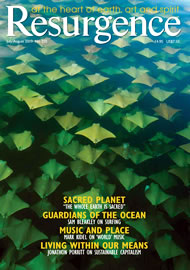Jane Hirshfield is an American poet, but her work is slowly becoming recognised in England through the enterprising poetry publishers Bloodaxe Books. First Bloodaxe published some of her poetry; now it has printed three lectures on poetics which the poet gave recently in Newcastle. Reading the lectures one can sense immediately their intimate connection with Hirshfield’s own work. For example, one of her poems, Those Who Cannot Act, goes as follows:
Those who act must suffer,
Suffer into truth –
What Aeschylus omitted:
Those who cannot act will suffer too.
The sister banished into exile.
The unnamed dog
Soon killed.
Even the bystanders vanish –
One by one,
Peripheral, in pain unnoticed while
The most memorable characteristic of this short poem is the way it refuses any kind of closure. The poem terminates in mid movement leaving the reader breathless, sensing an alarming gap, experiencing the emptiness. It dramatises its content by being in itself radically incomplete.
It is in no way surprising, then, that the three lectures gathered in this new volume celebrate the principles of indeterminacy and reticence. The first lecture defends the nature of what is hidden. Hirshfield offers a long litany of nouns – “mystery, secrecy, camouflage, silence, stillness, shadow, distance, opacity, withdrawal, namelessness, erasure, encryption, enigma, darkness, absence” – to evoke her theme. She continues by showing how these qualities are active in many sacred traditions and how they reveal themselves in some of the best poetry in all traditions of literature. (Her range is consistently wide and comprehensive.) As in Chinese paintings, what is not shown is as expressive as what is, and often provides the mysterious energy which animates the whole.
Such a poetics is clearly not ideologically strident or doctrinal. Quite the reverse. And it is the aim of the second lecture, on poetry and uncertainty, to bring this out more fully. The lecture sweeps over science, religion and the arts in order to demonstrate the power of Keats’ “negative capability” – that ability to be in a state of uncertainty and doubt without longing for premature resolution. For Hirshfield, the poet can be a kind of Socratic gadfly leading human consciousness into a “creative state of not-knowing”, the state named by the Greek philosophers aporia. The most moving example she gives of this falling into uncertainty is this short poem by Paul Celan:
No more sandart, no more book,
no masters.
Nothing on the dice. How many mute? Seventeen.
Your question – your answer.
Your song, what does it know?
Deepinsnow,
Eepinnow,
E-i-o.
Hirshfield points out how this strange elliptical poem erases itself from existence – the ultimate aporia – and yet does so in such a linguistic manner that it is permanently engraved on the reader’s mind. Impermanence thus secures a kind of permanence through art and memory – but the permanence
is about metaphysical impermanence. She also shows how in the hidden interior
of this tiny self-dissolving poem multiple associations and meanings are darkly in play. That so little can contain so much is one of her central tenets. A poem is a small vessel containing the greatest treasure.
The third and last lecture is devoted to the element of surprise. It includes a brief study of humour and the power of the joke which, so often, depends on the completely unexpected line and the sudden twist: “Would you hit a woman with a baby?” “No, I’d hit her with a brick.”
What is so marvellous is the way the poet defends the entirely useless. She writes: “As evolution’s creatures, we align with goal-attainment, self-protection and the useful. The part of art which is art, and not device, unshackles us from usefulness almost entirely.” And thus unshackled, we are taken into an infinitely larger universe – a multiverse which no animal inhabits. Indeed, the three lectures can be seen as an encomium to uselessness – and how necessary that is in our dull cage of pragmatism!
After finishing this gentle manifesto for poetry I wondered what else might be added to complete Hirshfield’s exploratory poetics. The place of musical cadence came to mind, as did, in our apocalyptic age, the place of divination and prophecy. Today far too many poems lack linguistic beauty and often miss entirely the metaphysical dimension. Perhaps in her next work Hirshfield will add these to her vital and eloquent agenda for poetry.







